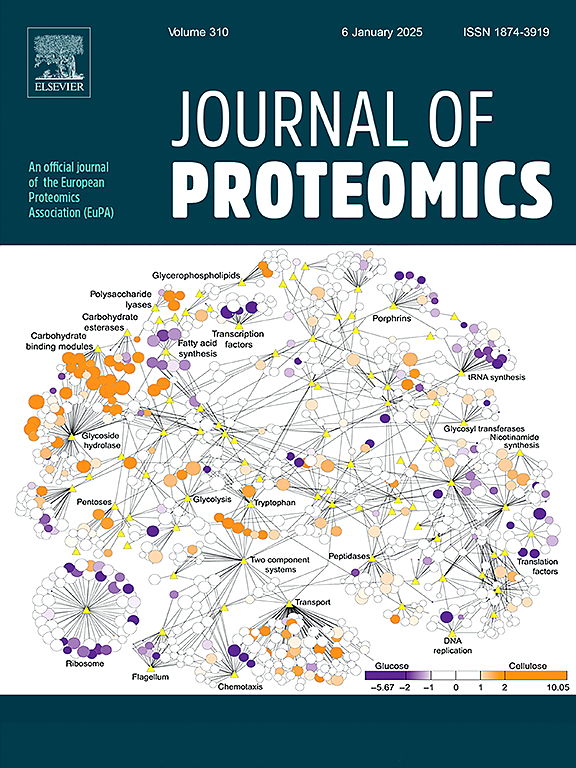金黄色葡萄球菌中赖氨酸酰化的底物分布及其功能意义。
IF 2.8
2区 生物学
Q2 BIOCHEMICAL RESEARCH METHODS
引用次数: 0
摘要
金黄色葡萄球菌(S. aureus)是一种主要的病原体,其翻译后修饰(PTMs)调节关键的生物学过程,对该病原体内的蛋白质功能产生重大影响。在本研究中,我们全面分析了金黄色葡萄球菌中三种赖氨酸酰化的总体模式,包括乙酰化、琥珀化和丙二醛化。通过质谱分析,我们鉴定出1249个乙酰化位点,871个琥珀化位点和67个丙二酰化位点。生物信息学分析进一步表明,赖氨酸乙酰化和琥珀酰化都与赖氨酸修饰位置附近的谷氨酸残基有优先关联。途径富集表明,修饰底物与核糖体和代谢功能有关。进一步的功能探索表明,赖氨酸琥珀酰化显著调节谷氨酰胺- trna氨基转移酶和氨甲酰磷酸合成酶的酶活性。总之,我们的研究增强了对金黄色葡萄球菌中赖氨酸琥珀酰化的理解,并在翻译后修饰水平上突出了与其致病性相关的潜在靶点。意义新:赖氨酸酰化在调节金黄色葡萄球菌的存活和致病性中起重要作用。然而,对金黄色葡萄球菌中赖氨酸酰基酶的全面和系统的研究仍然不足。在这项研究中,我们使用基于质谱的蛋白质组学技术对金黄色葡萄球菌亚种金黄色葡萄球菌ATCC 25923的三种赖氨酸酰化修饰进行了全面分析。目的是研究这些修饰对蛋白质功能的潜在影响。我们的生物信息学分析确定了赖氨酸酰化与核糖体和代谢途径之间的显著相关性。通过进一步的实验验证,我们证实了赖氨酸琥珀酰化对金黄色葡萄球菌谷氨酰胺- trna氨基转移酶和氨甲酰磷酸合成酶的活性具有重要的调节作用,从而对细胞能量代谢和蛋白质合成产生深远的影响。总之,我们的研究强调了金黄色葡萄球菌中赖氨酸酰化修饰在调节酶功能中的关键作用,从而为金黄色葡萄球菌的生物学提供了有价值的见解,并为潜在的治疗策略提供了信息。本文章由计算机程序翻译,如有差异,请以英文原文为准。

Characterization of substrate distribution and functional implication of lysine acylations in Staphylococcus aureus
Staphylococcus aureus (S. aureus) is a major pathogen whose post-translational modifications (PTMs) regulate key biological processes that exert a substantial impact on protein function within this pathogen. In this study, we comprehensively analyzed the overall patterns of three lysine acylation in S. aureus including acetylation, succinylation, and malonylation. Using mass spectrometry, we identified 1249 acetylated, 871 succinylated, and 67 malonylated sites. Bioinformatic analysis furtherly revealed that both lysine acetylation and succinylation exhibited a preferential association with glutamate residues near the modified lysine positions. Pathway enrichment showed that modified substrates were associated with ribosomes and metabolic functions. Additional functional exploration showed that lysine succinylation significantly regulates the enzymatic activity of Glutamyl-tRNA amidotransferase and Carbamoyl phosphate synthase. In conclusion, our study enhanced the comprehension of lysine succinylation in S. aureus and highlights potential targets related to its pathogenicity at the post-translational modification level.
Significance new
Lysine acylations play important roles in regulating bacterial survival and pathogenicity in Staphylococcus aureus. However, comprehensive and systematic investigations of the lysine acylomes in S. aureus remain insufficient. In this study, we conducted a comprehensive analysis of three lysine acylation modifications in Staphylococcus aureus subspecies aureus ATCC 25923 using mass spectrometry-based proteomic techniques. The objective was to investigate the potential impact of these modifications on protein function. Our bioinformatics analysis identified a significant correlation between lysine acylations and both ribosomal and metabolic pathways. Through additional experimental validation, we have substantiated that lysine succinylation plays a significant regulatory role in the activities of Glutamyl-tRNA amidinotransferase and Carbamoyl phosphate synthetase, consequently exerting a profound impact on cellular energy metabolism and protein synthesis in S. aureus.
Collectively, our study underscores the pivotal role of lysine acylation modifications in S. aureus in modulating enzyme function, thereby offering valuable insights into the biology of S. aureus and informing potential therapeutic strategies.
求助全文
通过发布文献求助,成功后即可免费获取论文全文。
去求助
来源期刊

Journal of proteomics
生物-生化研究方法
CiteScore
7.10
自引率
3.00%
发文量
227
审稿时长
73 days
期刊介绍:
Journal of Proteomics is aimed at protein scientists and analytical chemists in the field of proteomics, biomarker discovery, protein analytics, plant proteomics, microbial and animal proteomics, human studies, tissue imaging by mass spectrometry, non-conventional and non-model organism proteomics, and protein bioinformatics. The journal welcomes papers in new and upcoming areas such as metabolomics, genomics, systems biology, toxicogenomics, pharmacoproteomics.
Journal of Proteomics unifies both fundamental scientists and clinicians, and includes translational research. Suggestions for reviews, webinars and thematic issues are welcome.
 求助内容:
求助内容: 应助结果提醒方式:
应助结果提醒方式:


